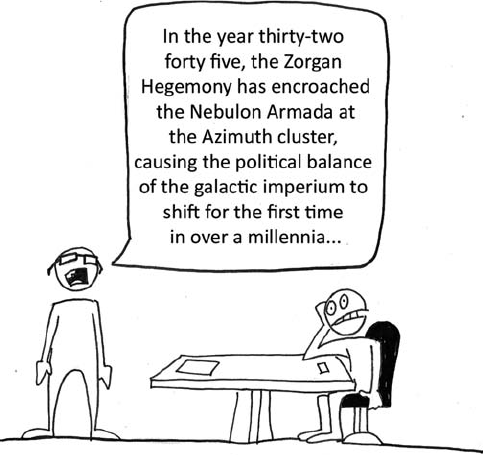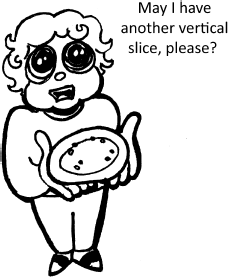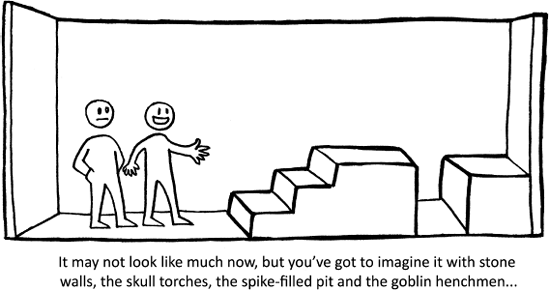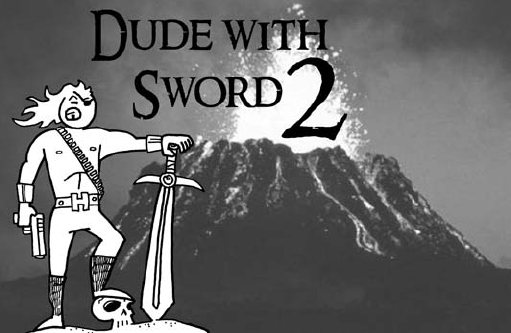If you followed the instructions in this book, you are now the proud creator of a great game idea and a 200-plus page game design document. You have everything you need to make an actual video game, right? Wrong! Your work is just beginning. Before you actually make the game, you will have to find a publisher to publish your game. And to find a publisher, you will need a pitch.
A pitch is a streamlined, easily digestible version of your game design document. It contains everything that's great and original about your game without all the "twiddley bits[178]."
Since most pitches are presented to groups in boardrooms, I highly recommend using Microsoft PowerPoint or some other presentation software to create your pitch document. To help, I have included an outline of what you should include in a pitch presentation in Bonus Level 9. The basics of this document are these:
Title screen with logo
Company profile
High concept
A few pages of details
Proof of why your game will be awesome/make everyone lots of money.
When creating a pitch presentation, remember the basics of making presentation slides: choose a font that you can read, don't put too much information on one page, and everyone loves pictures.
Putting together a good pitch presentation is like putting together an artist's portfolio: you want to show off your best work, but not include too many pieces and overwhelm your audience.

This was a story pitch I once sat through. The minute the writer started telling us the intricate machinations of his fantasy world, I tuned him out. It was just too much information to process at once. While worlds are fun to create and inventing a world's details is important to making a world feel real, realize that nobody else cares about your world and those details at this stage. I didn't care who the Nebulons were or what the significance of a Galactic Imperium was. I just wanted to know how the game played. Don't overburden your reader with story details. Keep it simple and more importantly, keep those details to yourself... for now.
Here are a few more rules of thumb when pitching:
Pitch to the right people. Just like when you created your game outline, you need to consider to whom you are selling your idea. Too many times, coming out of a pitch presentation, I've heard "That was a great pitch, but we'd never publish that type of game." This is sad, because if the developer had taken a little time to do some research about the publisher, that situation would have never happened. You don't want to waste your time (not to mention the publisher's). Some publishers only publish certain genres of games. Don't pitch a family game to a publisher who specializes in hardcore action games. That said, many publishers do publish a wide range of titles and their company objectives may change. Timing is everything. You may make a pitch right when the publisher decides they want to make a RTS about cybernetic death mecha piloted by farm animals. Then again, maybe not.
Pitch in a controlled environment. You can never be sure where a pitch presentation is going to take place, but you want to pitch your game in a location where the audience's attention is on you and your presentation. Pitching on the show floor of E3 = not good. Pitching in a private meeting room at E3 = much better.

Be prepared. Just like any other type of performance, you need to practice. Practice giving your pitch in front of your peers. Invite them to give you feedback on content as well as your performance. Don't be afraid to access your inner actor. You will be telling the story and the narrative of your game to the publisher, so you want to get them as excited about your game as you are excited to make it. If there is someone on your team better suited to speak in front of a group then have them give the presentation instead—with your supervision of course. You will still want to be present at the pitch to help them answer questions and fill in details. You want your game to shine in the best possible light and you only have one chance to impress. Make sure your computer is compatible with any type of set up, and always bring backup data on a thumb drive or disc. I have seen presentations stop cold because the sound isn't working correctly. Bring plenty of copies of documents. This is a little harder to predict because the number of attendees can be unpredictable. Here's another situation to consider: would you still be able to make your pitch if the power went out? So, as the Boy Scouts say, be prepared.
Know your project inside and out (and then some). Even though your game hasn't even been made yet, you should know everything you can about it. Publishers will ask questions to try and poke holes in your design. It's not that they're malicious; they're just looking for topics that may cause trouble once the game starts production. Be able to talk about your game in-depth but remember not to go on and on; you don't want to drown your audience in details unless they ask for them. If you don't know an answer to a question, it helps to say, I'd like to hear your thoughts on that."
Keep the focus. Production teams sometimes bring in several pitch ideas in an attempt to find out what the publisher is interested in. I'm not sure I agree with that strategy. More pitches means that (a) the meeting will go on longer, (b) less time will be spent on each game presentation, and (c) you may not get consensus on which idea is the best. There will always be one idea that stands out from the others, so why muddy the waters? I say let the attendees concentrate on that one idea. You may have to revisit the publisher to pitch another game idea. If you do present several ideas at a pitch meeting, then make sure that all of the presentations are at the same level of quality.
Pitch to represent. Even if you don't have a great game pitch or truly original idea, but you have a great piece of technology or a prototype gameplay mechanic then it may not hurt to present it to a publisher. Sometimes a publisher has a license but hasn't picked a studio to develop it into a game. Sometimes, timing and good luck play just as much a part of the pitch process as having a great game idea and strong presentation. In my 5 plus years working at a publisher and hearing scores of video game pitches, I have developed the "pitch equation":
Game demos are a lot of work. If not planned for properly, they take time away from the production of the main game. They can really disrupt the flow of your production and can lead to crunch time: long hours trying to get content into your game. However, demos show you are serious about making your game and allow potential publishers a chance to get their hands on code, which sometimes is the best way to sell the game.
Making video games may sound like fun and games, but it is a lot of hard work. It takes lots of effort and hours to design and create a game. And even after all of that hard work, a game that may seem like a "sure hit" may get poor reviews or mediocre sales. There are plenty of examples of well made and fun games that received great reviews and still did badly sales-wise. Sometimes the publisher may not be able to finance the promotion of the game to the level you feel it deserves. Sales projections may be set at levels that the game just can't reach. It's not all the publisher's fault though. Sometimes team members may not put their best work into the game; family and health issues may distract them from their jobs. God forbid your lead designer or a key team member gets sick or dies during production. Remember this very important thing:
These things happen, so you want to give your game a fighting chance to be the best possible. Most games that go badly are the result of bad planning. Here's a list for troubleshooting your game during production:
Plan ahead. Prepare for team illnesses and vacation. Prepare for hardware failure, brown-outs, or other technical issues.
Be smart when creating your design. Don't overpromise content and bite off more than the team can chew.
Try to lock down design and content as soon as possible; constantly changing content in the pursuit of perfection will eventually wear down your team and may even kill your game.
Players will always find ways to break your game, so make sure to play the game like they would. Don't just play the game the way it's "meant to be played." Do unusual things and bang on the game until it breaks. Then fix it and keep working.
If you are creating an international version of your games, make sure you account for sensitive cultural difference. For example, Titan Studios, the creators of Fat Princess (SCE, 2009) had to redesign their cartoony four-fingered game characters to have five fingers[179] for the game's release in Japan.
Find ways to remove design blinders, the phenomena that happens when you are too close to your game. It results in game creators thinking their game is too easy or half-baked elements "good enough." Recruit other people to play your game and give feedback. Use focus group testing when applicable and iterate on your game design in all stages of production. This is something that publishers are really good at... providing what I call the "10,000 foot view"—an objective look at your game. They'll help you identify weak spots and strengthen the good parts.
If something doesn't work, then throw it out. Don't be precious with your ideas. They're a dime a dozen. When you do throw something out, have a backup plan in mind. Don't make throwing away work a habit. It's better to plan things out to anticipate problems than to waste work. It's better to be getting rid of good ideas; that means you have too many good ideas! You can always use them on the sequel[180].
Cutting content happens in every game. But the more you cut during preproduction, the less you will have to cut during production. Make sure you are cutting content for the right reasons. Don't cut or change content that connect and have an impact on multiple game systems or you will be asking for trouble.
I don't want to go too much into game production (that could fill an entirely different book) but you should consider how to go about building your game. Some teams create a vertical slice that acts as a demo to be shown to publishers and a template for the rest of the game. A vertical slice is a level or sequence of your game that has been designed, built, and polished to the highest level of playability possible. A vertical slice has the highest quality of controls, camera, visuals, gameplay, code, effects, and audio that the final version of the game will have. Usually the target is 80% of final game quality. While experienced teams can create vertical slices in a matter of months, it is a very time-consuming process that can lead to crunch time—long working hours that can be very stressful to the team as they rush to create, insert and test content into the game.

A horizontal layer is another alternative to game production. The team bring all elements of the game, from beginning to end, "up" at the same time in gray box form. When creating gray box levels, geometry is roughly built and character animation assets are mostly placeholders. Details such as texturing, effects, and sound are generally absent at this point. Once all game assets have been play tested and approved, then the team oves on to the next step of "prettying up" and polishing the game even further.

The hardest thing about presenting gray box gameplay to other team members (and publishers and marketing partners, and so on) is that it requires them to use their imagination. Don't laugh, even in a creative industry such as making games, that ability is rarer than you'd think. The trick is to not let these people get the wrong idea about your game. Make sure there is concept art on hand to help communicate these visuals before they are in the game. What's great about this type of iteration is it gives the team a chance to play around with the game and discover what's great about it. If bouncing off of enemies' heads turns out to be more fun than fighting them, then it's not too late to adjust the design to compensate for the gameplay.
There is a design concept called emergent gameplay; gameplay that will "just happen" if the player is given a set of gameplay tools and a chance to play with them. However, the problem arises when designers use the concept of emergent gameplay as an excuse to underdesign gameplay, hoping that the player will "find the fun."

I say "emergent, eschmergent!" There's no such thing as accidental design. Knowing how all of the gameplay elements work with each other is part of the design process. If you take the time to plan and think about how the elements relate to each other, the outcomes of those relationships can be predicted. Granted, unusual relationships can emerge from bugs and other inconsistencies, but you should never plan your game design around those! If something unexpected does happen and it doesn't break your game, remember: "it's not a bug, it's a feature!"
Planning ahead. That's the secret to successful game production.

If your game reviews well or sells well, or if your publisher can afford to pay you a second time around, then you may get to make a sequel. Publishers like sequels. Now that I have worked for both a developer and a publisher, I think I have a good perspective on sequels. Just like in Hollywood, they are safe(r) bets: proven intellectual property (IP) that doesn't need to be explained to the audience: "if you loved the first one, you'll love the second!"
It's easy to understand why that is appealing to a publisher, but it's not without its problems. Sequels often sadly seem to represent a missed opportunity. Some teams just "phone in" or rush to make their sequel, creating retreads of the last game. Sequels should be treated as an opportunity to get it right. The first time you make a game, you are limited by several factors: you have to build a team, build an engine, figure out just what the heck this character and the gameplay is going to be. Get the whole thing to work and actually be fun. Then you hope that the audience is going to like and buy it. Once you've finished that, you've licked the hard part—especially if you've sold well enough to warrant a sequel. You should start your preproduction with the driving desire to make the game perfect[181].
For example, after finishing the first Maximo game, I went to my producer with a list of 40 things I thought were broken and needed to be fixed in the sequel (to my delight, I was able to get 39 of those requests fulfilled!). While the first game sold better, I still think the second game is a better game. We wouldn't have had the opportunity to make that better game if we didn't have a chance to make a sequel.
Besides, if there were no sequels, there would be no Grand Theft Auto 3, Call of Duty: Modern Warfare, Burnout Paradise, Curse of Monkey Island, Resident Evil 2 or Resident Evil 4, Lego Star Wars original trilogy... you get the idea. Here is some advice on making a video game sequel:
Use the "spine" of the original game as a basis of your gameplay design for the sequel. Take everything that was good in the first game and improve on it. Take everything that was bad and throw it away. It seems like common sense, but it's not all that common—things like lousy camera, controls, and gameplay mechanics are "justified" by teams because they were in the first game. Just because they were in the first game, doesn't mean they were that good. Don't be afraid to cut out the bad bits. If it's better than the original, no one will complain. My friend, project manager George Collins recommends that every sequel should be "30/70": 30 percent new material and ideas and 70 percent based on the original game. It's not a bad formula to follow.
Don't let the player down. They expect certain things in the sequel and you shouldn't disappoint. For example, if your audience loved the wall-running mechanic in your first game, then by all means, keep wall running in the sequel.
Name it something other than "GameName 2." Names are really important to a game. Personally, I think both the Batman (Batman Returns, Batman Begins, and so on) and the Indiana Jones and the... movie franchises did it right. Their titles are mysterious and keep furthering the fiction rather than reducing it to a numbered outing.
Always introduce something new... This may seem to be pandering to marketing, but make sure there are five new things in your game for the back of the box, preferably new gameplay concepts to bring something fresh. Also, try to introduce at least one new hero and villain to the franchise. Remind the player that this is a new experience, not just a rehash.
... But don't make it too new. In Maximo vs. Army of Zin, we didn't realize that the players wanted to fight more supernatural enemies; we had them battling clockwork creatures instead. The fans were unhappy because we deviated away from what they liked in the first title.
The further down the road you are, the more opportunity you have for change. Why not try doing something wildly different? This, of course, requires buy-in from your publisher and marketing department so it can be tricky to pull off. I've worked on franchises that were in their 5th, 8th or even 16th incarnation and sometimes a completely new direction is what it needed to shake things up. Give it a try, it worked for both the Grand Theft Auto and Wolfenstein franchises[182]!
Level 17's Universal Truths and Clever Ideas:
Demo > GDD > pitch presentation > pitch outline.
Cater your pitch to the right audience.
Be prepared for any technical problem.
Know your game completely to answer any question your audience might have.
Practice your pitch in front of an audience.
Video games are made by people: schedule in "people issues", both good and bad.
Remove designer blinders by looking at your game holistically and through focus testing.
Build games using either horizontal layer or vertical slice style production—pick one and go!
If something doesn't work in your game, throw it out, but try to plan ahead to avoid this.
Avoid crunch time with responsible design goals and detailed production planning.
Don't rely on emergent gameplay to make your game fun. All good design is preplanned.
Use the 30/70% rule when creating sequels: repeat all the stuff that was great in the first game, throw out everything that didn't work.
Don't let legacy keep your sequel down. Take a hard look at what can be improved from the first game.
Don't let the player down.
[178] "Twiddley bits" is game industry lingo for all the details you've worked really hard on but other people don't really need to hear about when you are telling them about your game. They're important to making the game, but not to selling it to a publisher.
[179] There are at least three explanations to why the four-fingered visual is considered taboo in Japan. Yubitsume is the practice done by members of the Yakuza; the cutting off at the knuckle of the pinkie finger as atonement. The resulting mutilated hand has the appearance of having four fingers. The number four, pronounced Shi, also means death. It's an unlucky number; much like 13 is in western cultures. The Burakumin are a social class that is still met with discrimination. The four-fingered sign was used to designate Burakumin (because they often worked with four-legged animals) and became a derogatory gesture. Modern Buraku activist groups have sued over the use of the four-fingered sign in Japanese media.
[180] S.I.F.S.—"save it for the sequel"—was a popular saying at many of the studios I worked at.
[181] OK, odds are you will never obtain perfection, but it's not a bad goal to shoot for. Then again, it didn't help Duke Nukem Forever, did it?
[182] Just be aware that it may not work too. Nothing is ever guaranteed in video games.
